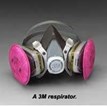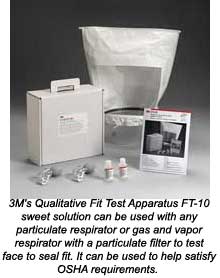Respirator fit testing: choosing the best method

By Craig E. Colton, C.I.H.
3M Occupational Health & Environmental Safety Division
Fit testing is the procedure to determine which model and size of respirator properly fits an individual so there is minimal face seal leakage. Employees required to wear a respirator must be fitted properly and tested for face seal leakage before using the respirator in a contaminated area. Annual fit testing is required by US Occupational Safety & Health Administration (OSHA) regulations (29 CFR 1910.134) and recommended by the American National Standards Institute guidelines for respiratory protection (ANSI Z88.2-1992) for all negative-pressure half and full facepiece air purifying respirators, as well as tight-fitting half facepiece and full facepiece positive pressure respirators. (A negative- pressure respirator is one in which the pressure inside the respirator is negative with respect to the positive pressure outside the respirator.)
Both OSHA and ANSI prohibit facial hair that interferes with respirator face seal. Instead, these employees should use powered air or supplied air hood or helmet respirator systems where facefit is not essential for proper respirator performance.
Qualitative or quantitative fit testing?
There are two fit test methods: qualitative fit testing and quantitative fit testing. Generally, qualitative fit testing is acceptable for most workplace airborne hazards. There are no data indicating that quantitative fit testing results in greater protection in the workplace. In fact, recent workplace protection studies have established the effectiveness of both fit testing methods.

Qualitative fit testing
A qualitative fit test (QLFT) is a pass/fail test that relies on the ability of the respirator wearer to sense a test agent by taste, smell, or irritation. OSHA accepts four QLFT protocols to identify unacceptable faceseal leakage, and each uses a different test agent. These test agents are isoamyl acetate (banana oil), saccharin, Bitrex, and irritant smoke. [Find 3M fit testing products in Comprehensive Training Programs .
Every tight-fitting respirator can be fit tested with at least one of the qualitative fit test agents. A respirator must be rejected as fitting inappropriately if the test agent is detected during a properly conducted fit test
Quantitative fit testing
Quantitative fit testing (QNFT) does not rely on a respirator wearer's sensitivity to a test agent. Instead, a quantitative fit test uses an instrument to measure presence of the test aerosol inside the facepiece. This requires that the respirator be equipped with adapters or probes that allows air to be sampled from inside the respirator. To guard against filter penetration, the respirator must also be equipped with level 100 filters.
The term "fit factor" is used to express the results of a quantitative fit test. A fit factor is the ratio of the test agent concentration outside the respirator to the test agent concentration inside the respirator. Respirator fit is rejected if the overall fit factor does not meet the pass criteria, which is generally 10 times the assigned protection factor for the negative-pressure respirator tested. A variety of materials have been used as QNFT test agents, including oil mists, salt particles, ambient dust particles, and sulfur hexafluoride gas.
Comparing fit test methods
Each method has advantages and disadvantages. QNFT is expensive, requiring costly instrumentation, (approximately US$7,000) as well as expenditures for additional adapters or probed respirators. Also, quantitative fit tests must be conducted by a highly trained operator who understands how to use the equipment, perform preventive equipment maintenance, check for system leaks, and conduct system calibrations. In contrast, qualitative fit tests are convenient and easy to perform. The equipment used is also much less expensive, only about $200. Quantitative fit testing is not more accurate than qualitative fit testing. Not surprisingly, QLFT is more widely used.

Selecting the best method
Selecting the best fit test method can only be made after considering several criteria. These include:
Fit testing is an important and required element of a respiratory protection program. Training materials, including fitting posters, videos, selection guides, face fit products, software programs, and written administrative respiratory protection programs can help ensure OSHA compliance and worker safety. [Find all these fit testing training materials, products, and software in Comprehensive Training Programs .
